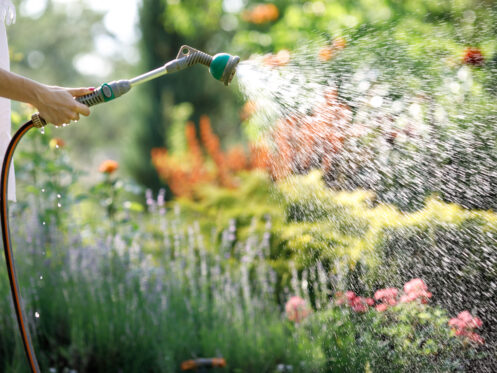Water is a precious resource, and conserving it is essential for the health of the planet. Water conservation in gardening not only addresses environmental concerns but also allows us to save money on our water bills. With the increasing threats of climate change and water scarcity, it’s more important now than ever to adopt sustainable practices in our everyday lives, including in our gardens.
Flower gardens can consume a significant amount of water, especially during the hot summer months. By instituting effective water conservation strategies, we can cut our water consumption in half and create a more sustainable garden.
This article will walk you through practical water-saving measures for your garden, allowing you to keep a lush and vibrant outdoor space while being mindful of how much water you’re using. We’ll look at everything from effective irrigation systems to soil preparation, plant selection, and maintenance practices to see how they might help reduce water waste and promote sustainable gardening.
Understanding Your Garden’s Water Needs
Understanding the water needs of your garden is crucial for efficient water usage. Different plants have different water requirements, and it’s important to group them accordingly. By assessing your garden’s water needs, you can create zones based on the water requirements of the plants in each area. This allows you to water more efficiently and avoid overwatering or underwatering certain plants.
One way to assess your garden’s water needs is to observe how quickly the soil dries out after watering. If the soil is still moist several inches below the surface, it indicates that the plants are receiving sufficient water. On the other hand, if the soil is dry and crumbly, it may be a sign that the plants are not getting enough moisture.
Effective Irrigation Techniques
One of the best ways to save water in your garden is to set up an efficient irrigation system. Traditional sprinklers can be wasteful because a lot of the water evaporates, runs off, or sprays onto areas where it’s not needed.
Drip Irrigation
Instead of sprinklers, consider installing a drip irrigation system or using soaker hoses. Drip irrigation slowly releases water directly onto the soil around each plant’s roots, where it’s needed most. This prevents water from being lost to evaporation or runoff. Soaker hoses do a similar job by slowly soaking the soil, allowing the water to be absorbed deeply into the ground.
Setting up drip irrigation or using soaker hoses does require some initial cost and work. But in the long run, it will save you a lot of water and make watering your garden much easier. With a well-planned system, you can make sure each plant gets just the right amount of water without any waste.
Collecting Rainwater
Another way to save water is to collect and reuse water from different sources around your home. You can install a rain barrel to collect rainwater that falls on your roof. Or you can set up a greywater recycling system to capture and reuse water from sinks, showers, and washing machines. Using this recycled water for your garden reduces your need for fresh water from lakes, rivers, or underground sources.
By installing an efficient drip system or soaker hoses, you’re making sure the water gets directly to the roots without any of it being wasted. And by collecting rainwater or greywater, you’re using free sources instead of relying solely on fresh water from utilities. It’s a smart, two-part strategy to conserve water while keeping your plants healthy and hydrated.
Preparing the Soil
Properly preparing your garden’s soil and using mulch can help it retain moisture better so you won’t have to water as often. This prevents wasted water from evaporating or running off.
Adding organic matter, like compost or aged manure, to your garden soil is key. These materials create a loose soil texture that allows water to soak in deeply while still holding onto moisture for a long time.
Using Mulch
Mulching is another great technique. Spreading a layer of mulch (like wood chips, leaves, or straw) around your plants acts as a protective blanket that stops water from evaporating out of the soil too quickly. Mulch also blocks weeds from growing and competing with your plants for water.
Aim for about 2 to 4 inches of mulch, but don’t let it touch the plant stems or tree trunks directly. You’ll need to replenish the mulch once or twice per year as it decomposes over time.
By preparing your soil correctly with organic matter and applying a thick mulch covering, you’re setting up your garden to act like a sponge — absorbing water deeply and holding onto it for a long time. This means you’ll need to water less often and waste less of this precious natural resource.
Choosing the Right Plants
The types of plants you choose and where you put them in your garden can make a huge difference in how much water you’ll need to use. Whenever possible, pick species that are native to your local area or varieties that don’t require much water (called drought-tolerant plants). These plants have naturally adapted to survive in your climate’s typical weather and soil conditions without needing tons of extra watering.
For example, if you live somewhere with hot, dry summers, opt for water-sipping plants like lavender, rosemary, agave, or yucca. In cooler, wetter areas, drought-tolerant choices could include sedum, yarrow, or ornamental grasses.
It also helps to group plants that have similar water needs — a technique called “hydrozoning.” This way, you can water each hydrozoned area based on what those specific plants require, rather than overwatering some while underwatering others.
Using drought-tolerant trees and large shrubs as windbreaks or barriers around your garden is smart too. These plants can shade the rest of your garden and block hot, drying winds, creating a better microclimate that requires less supplemental watering.
With careful planning of which plants go where, you can design a low-maintenance, water-efficient landscape that looks amazing while supporting your local environment.
Effective Watering
When it comes to watering your garden, timing is everything. The best times to water are early in the morning or late in the evening. During these cooler periods, there is less evaporation compared to the hot midday hours. This simple habit can help reduce wasted water.
You also want to make sure you’re watering the soil directly instead of just getting the leaves and plant tops wet. Aim the water at the base of each plant so the moisture goes straight to the root zone where it’s needed most.
By timing your watering sessions for cooler temperatures and focusing on getting that water into the soil efficiently, you’ll be giving your thirsty plants a nice, deep drink without any of that precious water going to waste.
Final Thoughts
Using water-saving methods in your garden doesn’t just help preserve natural resources and protect the environment. It also ensures that all your hard work cultivating plants in your landscape will pay off for years to come.
With efficient irrigation, proper soil preparation, mindful plant selection, and smart watering routines, you can grow and maintain a lush, thriving garden while doing your part to conserve water.
Where to Get Help
If you need help setting up systems like drip irrigation or rain barrel installation to make your water-saving garden a reality, the experts at Plumbtree Plumbing & Rooter] are here for you. Our experienced plumbers can ensure your irrigation and rainwater catchment systems are installed correctly for maximum water efficiency. You can also rely on us for a full array of plumbing, gas, and sewer services from repairing or installing pipes and clearing clogged drains to leak detection and water heater installation. If you’re in or near San Jose, CA, call us today to start conserving water and money while still enjoying a lush, thriving garden!

